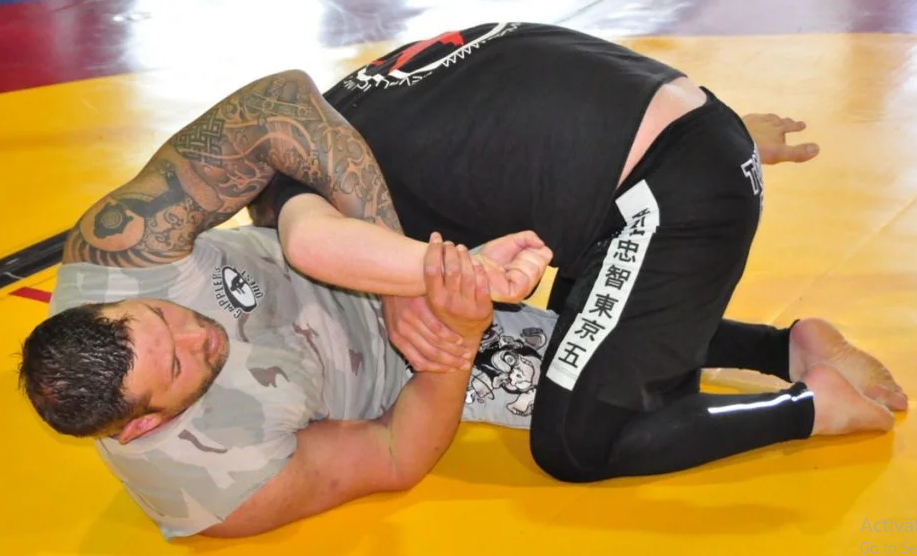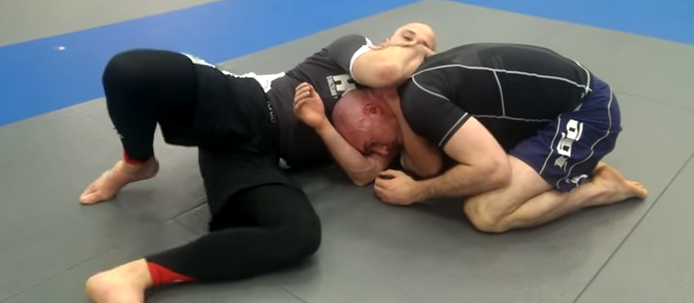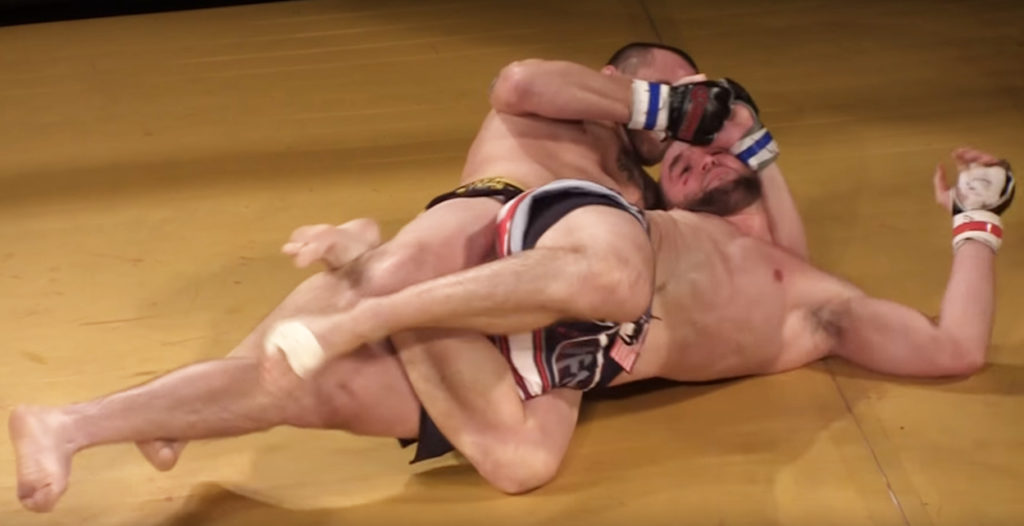This Top 10 Deadliest Jiu-Jitsu Submissions list came to mind while watching some videos on Youtube of Metamoris. The now-defunct promotion company that was host to many great jiu-jitsu competitions.
It had me thinking – Jiu-jitsu is known for having a strong reputation for grappling. Some of the greatest UFC fighters have won their matches using a Jiu-Jitsu submission – so I thought I’d write about these moves.
I’ll list Jiu-jitsu submissions that are sure to leave your opponent helpless on the ground. From chokes to armlocks, these techniques will have you dominating the mats in no time.
Whether you are a beginner looking for new strategies, or a seasoned practitioner looking for new ways to tap-out your opponent, these submissions will have you covered.
Related Topics:
10) Armbar
Although an armbar is one of the first and basic submissions you learn in jiu-jitsu, it’s one of the most deadliest.
What is an armbar?
An armbar is a submission hold that is used to restrain an opponent’s arm. It is a very effective submission hold that can be used in a variety of grappling styles, including Brazilian Jiu Jitsu, judo, and wrestling.
People often ask can you break someone’s arm with an armbar? The answer is yes!
An armbar from mount position can can really cause damage to your opponent. If you apply enough pressure when straightening out the arm, locked in position, you can completely disable the arm.
It’s all about positioning and if you have the arm locked in correctly. Whether you break it or dislocate it doesn’t matter. You’re still doing vital damage to the person’s arm.
Watch any UFC match or jiu-jitsu competition, and see when a competitor is in an armbar if he doesn’t tap-out right away. They don’t want to risk their arm being dislocated.
With that being said it still does happen to some fighters. It can happen quickly. It’s all apart of fighting.

9) Hammerlock
The Hammerlock is a devastating submission that can pop your opponent’s shoulder out of place. It’s a move often seen being used by the police.
The Hammerlock can be set up from the top closed guard, pinning his arm, or from the bottom closed guard. This is what happens in sequence:
- You opponent’s arm is bent behind his back.
- Your opponent’s arm is then pushed upwards toward the neck.
- The force of the move will make him tap because the amount of pressure on his shoulder joint.
8) Kimura
The Kimura was created by Japanese Judo legend, jiu-jitsu competitor, and professional wrestler. It was introduced to the world in the infamous jiu-jitsu match between Masahiko Kimura and Helio Gracie.
Kimura managed to put Helio is the submission hold and expected him to tap-out after a few seconds, b Helio couldn’t because he was unconscious. Not knowing that Kimura continued to twist his arm even further.
This ultimately broke Helio’s arm. The pain brought him back to consciousness. Kimura was going to bend Helio’s arm even further, but Helio’s brother Carlos threw in the towel and the referee stopped the fight.
From that day forward the submission was called the Kimura to honor its founder’s name – Masahiko Kimura.
As you can tell the Kimura arm lock is a deadly submission. It can render you unconscious and even dislocate or break your arm.
7) Arm Triangle Choke
The arm triangle choke is a submission hold that is used in MMA to immobilize an opponent’s neck.
To perform the triangle choke, the fighter grasps one of their opponent’s arms with their left hand, and wraps their right arm around the opponent’s head, pulling it down towards their chest.
Once the Triangle choke is in deep it’s impossible to reverse. On average this choke takes about 8-13 seconds to put you to sleep. It’s wise for you to tap right away if placed in this choke.
If you’re the one applying this choke submission to your opponent be careful because it’s extremely dangerous.

6) D’arce Choke
The D’arce choke or also knon as the no gi Brabo choke, was created by a third-degree Brazilian Jiu-Jitsu black belt named Joe D’arce.
The D’arce choke is commonly used in jiu-jitsu competitions around the world and in combat sports such as UFC and Bellator.
There are many ways to set up this submission and many ways to finish it as well. The one fighter that has used it the most in the UFC is non other than Tony Furguson.
It always use to be fun watching him set it up and finishing it beautifully.
Here are others to watch that have done the D’arce choke well in competition, and also teach it to their students.
- Jeff Glover
- Ryan Hall
- Cobrinha
- Robert Drysdale
- Edwin Najmi
- Bill Cooper
5) Ninja Choke
Not many fighters or jiu-jitsu enthusiasts know about the Ninja Choke. I often mention it to fighters and they’re always like “what’s that?”
When I’m in the gym and I mention it to students they’re as equally puzzled. They have no clue what the move is.
The Ninja Choke ws introduced to the MMA world by Shuichiro Katsumura, and it was a move that won him the Shooto featherweight crown.
The Ninja Choke is a variation of the guillotine choke and once locked in tight you will go unconscious within seconds.
This is a great submission to set up from guard and is very sneaky. Your opponent won’t know what hit him!
.
4) Peruvian Necktie
Out of all the submissions listed so far, I would have to say that the Peruvian Necktie is the hardest to set up. But once you got it, it’s all over for your opponent. Sing him a lullaby because it’s bed time.
To execute this move you will use your legs to control your opponent, and put pressure on their head while your arms are grasped around the neck.
Applying extra pressure from the legs will make it a painful hold to get stuck in. Your opponent should tap-out right away.
3) Omoplata
Omoplata is a submission hold that is used to control the opponent by immobilizing their shoulder.
It is one of the most versatile submissions in Brazilian Jiu-Jitsu, and can be used in a variety of ways to finish the fight.
This is a move also used in Judo (ashi sankaku garami) and Catch westling (coil lock).
The technique involves taking your legs and hips and using it to extend your opponent’s shoulder joint past its normal range of motion.
If done correctly and with force, you can actually dislocate someone’s shoulder out of place.
Americana Submission From Mount Position

2) Twister
The Twister is a phenomenal submission that’s exciting to see a fighter execute. It’s a submission used in Brazilian Jiu-jitsu and MMA.
It was created by Eddie Bravo a BJJ legend and owner of 10th Planet Jiu-Jitsu. The Twister submission has only been used by one fighter in the UFC and that’s Jung Chan-sung aka the Korean Zombie.
This is an attack from back control – the move cranks on the neck while twisting the body in the opposite direction – quickly putting pressure on the spine.
This submission is so dangerous that it is illegal to use in the International Brazilian Jiu-Jitsu Federation.
1) Heel Hook
The number one top 10 deadliest jiu-jitsu submissions is the Heel Hook. the heel hook is one of the deadliest submission to put an opponent in.
The heel hook lets you twist on the joints in the ankle by cranking on the heel. It’s extremely painful. It has made many fighters tap-out including legendary former middleweight champion Anderson Silva.
I wrote about how to do a heel hook in on of my previous articles, and it has received much views and praise.
For many years the heel hook has been banned from jiu-jitsu competitions due to the permanent damage it can have on a fighters knee and heel.
The International Brazilian Jiu-jitsu banned it completely for many years, and in 2021 reinstated it, making it legal to do leg reaping.
Black and brown belt adults can now use reaping techniques in no-gi competition. Including the inside sankaku position.
IBJJ – New Rules Concerning Heel Hooks
The Black Belt Blueprint: An Intelligent Approach to Brazilian Jiu Jitsu
“The Black Belt Blue Print” is a must have for true students of jiu jitsu. Concise, yet comprehensive, it’s the guidebook I secretly yearned for when I began training. With wisdom and experience on every page, this book will enhance your journey in the gentle art.” Roy Dean – BJJ Black Belt

Click on image above
Written by Roger Gracie’s first black belt and founder of the Jiu Jitsu Brotherhood, Nicolas Gregoriades, this is a comprehensive guide to the sport of Brazilian Jiu Jitsu.
It features a detailed and holistic approach to the training methods, techniques and concepts which underpin the art.


